Thomas Carlyle
Thomas Carlyle (4 December 1795 – 5 February 1881) was a British historian, satirical writer, essayist, translator, philosopher, mathematician, and teacher. In his book On Heroes, Hero-Worship, and The Heroic in History (1841), he argued that the actions of the "Great Man" play a key role in history, claiming that "the history of the world is but the biography of great men".[1] Other major works include The French Revolution: A History, 3 vols (1837) and The History of Friedrich II of Prussia, Called Frederick the Great, 6 vols (1858–65).[2]
Thomas Carlyle | |
|---|---|
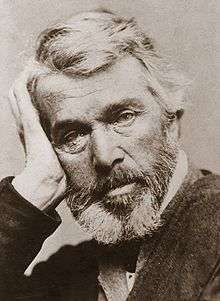 Photo by Elliott & Fry, c.1860s | |
| Born | 4 December 1795 |
| Died | 5 February 1881 (aged 85) |
| Occupation | Historian, satirist, essayist, translator, mathematician |
| Known for |
|
| Spouse(s) | |
| Writing career | |
| Alma mater | University of Edinburgh |
| Literary movement | Victorian literature |
| Notable works | |
| Signature | |
| Part of a series on |
| Conservatism |
|---|
 |
|
Concepts
|
|
Organizations
|
|
Religious conservatism
|
|
National variants |
|
His 1837 history of The French Revolution was the inspiration for Charles Dickens' 1859 novel A Tale of Two Cities, and remains popular today. Carlyle's 1836 Sartor Resartus is a notable philosophical novel.
A noted polemicist, Carlyle coined the term "the dismal science" for economics, in his essay "Occasional Discourse on the Negro Question", which advocated for the reintroduction of slavery to the West Indies.[3][4] He also wrote articles for the Edinburgh Encyclopaedia.[5]
Once a Christian, Carlyle lost his faith while attending the University of Edinburgh, later adopting a form of deism.[6]
In mathematics, he is known for the Carlyle circle,[7] a method used in quadratic equations and for developing ruler-and-compass constructions of regular polygons.
Early life and influences
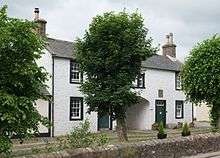
Carlyle was born in 1795 in Ecclefechan in Dumfriesshire.[4] His parents determinedly afforded him an education at Annan Academy, Annan, where he was bullied and tormented so much that he left after three years.[8] His father was a member of the Burgher secession Presbyterian church.[9] In early life, his family's (and nation's) strong Calvinist beliefs powerfully influenced the young man.
After attending the University of Edinburgh, Carlyle became a mathematics teacher,[4] first in Annan and then in Kirkcaldy, where he became close friends with the mystic Edward Irving. (Confusingly, there is another Scottish Thomas Carlyle, born a few years later, connected to Irving via work with the Catholic Apostolic Church.[10])
In 1819–21, Carlyle returned to the University of Edinburgh, where he suffered an intense crisis of faith and conversion, which provided the material for Sartor Resartus ("The Tailor Re-tailored"), which first brought him to the public's notice.
Carlyle developed a painful stomach ailment, possibly gastric ulcers,[11] that remained throughout his life and likely contributed to his reputation as a crotchety, argumentative, somewhat disagreeable personality. His prose style, famously cranky and occasionally savage, helped cement an air of irascibility.[12]
Carlyle's thinking became heavily influenced by German idealism, in particular, the work of Johann Gottlieb Fichte. He established himself as an expert on German literature in a series of essays for Fraser's Magazine, and by translating German works, notably Goethe's novel Wilhelm Meisters Lehrjahre.[4] He also wrote a Life of Schiller (1825).[4]
In 1826, Thomas Carlyle married fellow intellectual Jane Baillie Welsh, whom he had met through Edward Irving during his period of German studies.[4] In 1827, he applied for the Chair of Moral Philosophy at St Andrews University but was not appointed.[13] They moved to the main house of Jane's modest agricultural estate at Craigenputtock, Dumfriesshire, Scotland.[4] He often wrote about his life at Craigenputtock – in particular: "It is certain that for living and thinking in I have never since found in the world a place so favourable." Here Carlyle wrote some of his most distinguished essays and began a lifelong friendship with the American essayist Ralph Waldo Emerson.[4]
In 1831, the Carlyles moved to London, settling initially in lodgings at 4 (now 33) Ampton Street, Kings Cross. In 1834, they moved to 5 (now 24) Cheyne Row, Chelsea, which has since been preserved as a museum to Carlyle's memory. He became known as the "Sage of Chelsea", and a member of a literary circle which included the essayists Leigh Hunt and John Stuart Mill.[4]
Here Carlyle wrote The French Revolution: A History (2 volumes, 1837), a historical study concentrating both on the oppression of the poor of France and on the horrors of the mob unleashed. The book was immediately successful.
Writing career
Early writings
By 1821, Carlyle abandoned the clergy as a career and focused on making a living as a writer. His first fiction, Cruthers and Jonson, was one of several abortive attempts at writing a novel. Following his work on a translation of Goethe's Wilhelm Meister's Apprenticeship,[4] he came to distrust the form of the realistic novel and so worked on developing a new form of fiction. In addition to his essays on German literature, he branched out into wider-ranging commentary on modern culture in his influential essays Signs of the Times and Characteristics.[14] In the latter, he laid down his abiding preference for the natural over the artificial: "Thus, as we have an artificial Poetry, and prize only the natural; so likewise we have an artificial Morality, an artificial Wisdom, an artificial Society".[15]
Moreover, at this time he penned articles appraising the life and works of various poets and men of letters, including Goethe, Voltaire and Diderot.
Sartor Resartus

His first major work, Sartor Resartus (lit. 'The Tailor Re-tailored') was begun as a satirical article on "the philosophy of clothes" and surprised him by growing into a full-length book. He wrote it in 1831 at the house on his wife Jane's estate, Craigenputtock,[4] and it was intended to be a new kind of book: simultaneously factual and fictional, serious and satirical, speculative and historical. Ironically, it commented on its own formal structure while forcing the reader to confront the problem of where "truth" is to be found. Sartor Resartus was first published in instalments in Fraser's Magazine from 1833 to 1834.[4] The text presents itself as an unnamed editor's attempt to introduce the British public to Diogenes Teufelsdröckh, a German philosopher of clothes, who is, in fact, a fictional creation of Carlyle's. The Editor is struck with admiration, but for the most part is confounded by Teufelsdröckh's outlandish philosophy, of which the Editor translates choice selections. To try to make sense of Teufelsdröckh's philosophy, the Editor tries to piece together a biography, but with limited success. Underneath the German philosopher's seemingly ridiculous statements, there are mordant attacks on Utilitarianism and the commercialization of British society. The fragmentary biography of Teufelsdröckh that the Editor recovers from a chaotic mass of documents reveals the philosopher's spiritual journey.[16] He develops a contempt for the corrupt condition of modern life. He contemplates the "Everlasting No" of refusal, comes to the "Centre of Indifference", and eventually embraces the "Everlasting Yea".[16] This voyage from denial to disengagement to volition would later be described as part of the existentialist awakening.
Given the genre-breaking nature of Sartor Resartus, it is not surprising that it at first achieved little attention. Its popularity developed over the next few years, and it was published as a single volume in Boston 1836, with a preface by Ralph Waldo Emerson, influencing the development of New England Transcendentalism. The first British book edition followed in 1838.
The Everlasting No and Yea
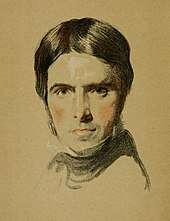
"The Everlasting No" is Carlyle's name for the spirit of unbelief in God, as embodied in the Mephistopheles of Goethe, which is forever denying the reality of the divine in the thoughts, the character, and the life of humanity, and has a malicious pleasure in scoffing at everything high and noble as hollow and void.[17]
"The Everlasting Yea" is Carlyle's name in the book for the spirit of faith in God in an attitude of clear, resolute, steady, and uncompromising antagonism to the "Everlasting No", and the principle that there is no such thing as faith in God except in such antagonism to the spirit opposed to God.[18]
In Sartor Resartus, the narrator moves from the "Everlasting No" to the "Everlasting Yea," but only through "The Centre of Indifference," a position of agnosticism and detachment. Only after reducing desires and certainty, aiming at a Buddha-like "indifference", can the narrator realize affirmation. In some ways, this is similar to the contemporary philosopher Søren Kierkegaard's "leap of faith" in Concluding Unscientific Postscript.
Worship of Silence and Sorrow
Following Goethe's description of Christianity as the "Worship of Sorrow", and "our highest religion, for the Son of Man", Carlyle interprets this as "there is no noble crown, well worn or even ill worn, but is a crown of thorns".[19]
"The "Worship of Silence" is Carlyle's name for the sacred respect for restraint in speech till "thought has silently matured itself, ... to hold one's tongue till some meaning lie behind to set it wagging," a doctrine which many misunderstand, almost wilfully, it would seem; silence being to him the very womb out of which all great things are born."[20]
The French Revolution
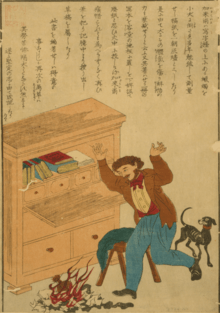
In 1834, Carlyle and his wife left Craigenputtock for London and began to network in intellectual circles.[4] Within the United Kingdom, establishing his own reputation with the publication of his three-volume work The French Revolution: A History in 1837.[4] After the completed manuscript of the first volume was accidentally burned by a maid of the philosopher John Stuart Mill, Carlyle wrote the second and third volumes before rewriting the first from scratch.[8][11]
The work had a passion surprising in historical writing of that period. In a politically charged Europe, filled with fears and hopes of revolution, Carlyle's account of the motivations and urges that inspired the events in France seemed powerfully relevant. Carlyle stressed the immediacy of action – often using the present tense – and incorporated different perspectives on the events he described.[21]
For Carlyle, chaotic events demanded what he called "heroes" to take control over the competing forces erupting within society. While not denying the importance of economic and practical explanations for events, he saw these forces as "spiritual" – the hopes and aspirations of people that took the form of ideas, and were often ossified into ideologies ("formulas" or "isms", as he called them). In Carlyle's view, only dynamic individuals could master events and direct these spiritual energies effectively: as soon as ideological "formulas" replaced heroic human action, society became dehumanized. Like the opinions of many thinkers of the time, these ideas were influential on the development and rise of both socialism and fascism.[22]
Charles Dickens used Carlyle's work as a secondary source for the events of the French Revolution in his novel A Tale of Two Cities.[23]
Heroes and Hero Worship
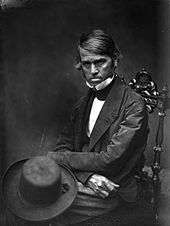
Carlyle moved towards his later thinking during the 1840s, leading to a break with many old friends and allies, such as Mill and, to a lesser extent, Emerson. His belief in the importance of heroic leadership found form in the book On Heroes, Hero-Worship, and The Heroic in History, in which he was seen to compare a wide range of different types of heroes, including Odin, Muhammad, Oliver Cromwell, Napoleon, William Shakespeare, Dante, Samuel Johnson, Jean-Jacques Rousseau, Robert Burns, John Knox, and Martin Luther.[24] These lectures of Carlyle's are regarded as an early and powerful formulation of the Great Man theory of historical development.
For Carlyle, the hero was somewhat similar to Aristotle's "magnanimous" man – a person who flourished in the fullest sense. However, for Carlyle, unlike Aristotle, the world was filled with contradictions with which the hero had to deal. All heroes will be flawed. Their heroism lay in their creative energy in the face of these difficulties, not in their moral perfection. To sneer at such a person for their failings is the philosophy of those who seek comfort in the conventional. Carlyle called this "valetism", from the expression "no man is a hero to his valet."[25]
Past and Present
In 1843, he published his anti-democratic Past and Present, with its doctrine of ordered work.[26] In it, he influentially called attention to what he termed the "Condition of England" saying "England is full of wealth...supply for human want in every kind; yet England is dying of inanition".[27] Past and Present combines medieval history with criticism of 19th-century British society. Carlyle wrote it in seven weeks as a respite from the harassing labor of writing Cromwell. He was inspired by the recently published Chronicles of the Abbey of Saint Edmund's Bury, which had been written by Jocelin of Brakelond at the close of the 12th century. This account of a medieval monastery had taken Carlyle's fancy, and he drew upon it in order to contrast the monks' reverence for work and heroism with the sham leadership of his own day.
Later work
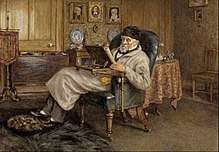
All these books were influential in their day, especially on writers such as Charles Dickens and John Ruskin. However, after the Revolutions of 1848 and political agitations in the United Kingdom, Carlyle published a collection of essays entitled Latter-Day Pamphlets, in 1850, in which he attacked democracy as an absurd social ideal, mocking the idea that objective truth could be discovered by weighing up the votes for it, while equally condemning hereditary aristocratic leadership as a "deadening." The government should come from those ablest to lead, Carlyle asserted. Two of these essays, No. I: "The Present Times" and No. II: "Model Prisons" was reviewed by Karl Marx and Friedrich Engels in April 1850.[28] Marx and Engels state their approval of Carlyle's criticisms against hereditary aristocracy; however, they harshly criticize Carlyle's views as "a thinly disguised acceptance of existing class rule" and an unjust exoneration of statism.[29] Anthony Trollope for his part considered that in the Pamphlets "the grain of sense is so smothered in a sack of the sheerest trash.... He has one idea – a hatred of spoken and acted falsehood; and on this, he harps through the whole eight pamphlets".[30] A century later, Northrop Frye would similarly speak of the work as "tantrum prose" and "rhetorical ectoplasm."[31]
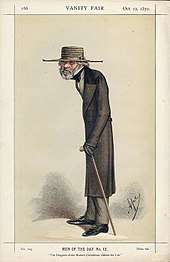
In later writings, Carlyle sought to examine instances of heroic leadership in history. The Letters and Speeches of Oliver Cromwell (1845) presented a positive image of Cromwell: someone who attempted to weld order from the conflicting forces of reform in his own day. Carlyle sought to make Cromwell's words live in their own terms by quoting him directly and then commenting on the significance of these words in the troubled context of the time. Again this was intended to make the past "present" to his readers: "he is epic, still living".[32]
His essay "Occasional Discourse on the Negro Question" (1849) suggested that slavery should never have been abolished, or else replaced with serfdom. It had kept order, he argued, and forced work from people who would otherwise have been lazy and feckless: "West Indian blacks are emancipated and, it appears, refuse to work".[33] This, and Carlyle's support for the repressive measures of Governor Edward Eyre in Jamaica during the Morant Bay rebellion,[26] further alienated him from his old liberal allies. As Governor of the Colony, Eyre, fearful of an island-wide uprising, forcibly suppressed the rebellion and had many black peasants killed. Hundreds were flogged. He also authorized the execution of George William Gordon, a mixed-race colonial assemblyman who was suspected of involvement in the rebellion. These events created great controversy in Britain, resulting in demands for Eyre to be arrested and tried for murdering Gordon. John Stuart Mill organised the Jamaica Committee, which demanded his prosecution and included some well-known British liberal intellectuals (such as John Bright, Charles Darwin, Frederic Harrison, Thomas Hughes, Thomas Henry Huxley, and Herbert Spencer).
Carlyle set up rival Governor Eyre Defence and Aid Committee for the defence, arguing that Eyre had acted decisively to restore order.[34] His supporters included John Ruskin, Charles Kingsley, Charles Dickens, Alfred Tennyson and John Tyndall. Eyre was twice charged with murder, but the cases never proceeded.
Similar hard-line views were expressed in Shooting Niagara, and After?, written after the passing of the Electoral Reform Act of 1867 in which he "reaffirmed his belief in wise leadership (and wise followership), his disbelief in democracy and his hatred of all workmanship – from brickmaking to diplomacy – that was not genuine."[35]
Frederick the Great
His last major work was History of Friedrich II of Prussia, an epic life of Frederick the Great (1858–1865). In this Carlyle tried to show how a heroic leader can forge a state, and help create a new moral culture for a nation. For Carlyle, Frederick epitomized the transition from the liberal Enlightenment ideals of the eighteenth century to a new modern culture of spiritual dynamism embodied by Germany, its thought and its polity. The book is most famous for its vivid, arguably very biased, portrayal of Frederick's battles, in which Carlyle communicated his vision of almost overwhelming chaos mastered by the leadership of genius.
Carlyle struggled to write the book, calling it his "Thirteen Years War" with Frederick. Some of the nicknames he came up with for the work included "the Nightmare," "the Minotaur," and "the Unutterable book".[36] In 1852, he made his first trip to Germany to gather material, visiting the scenes of Frederick's battles and noting their topography. He made another trip to Germany to study battlefields in 1858. The work comprised six volumes; the first two volumes appeared in 1858, the third in 1862, the fourth in 1864 and the last two in 1865. Emerson considered it "Infinitely the wittiest book that was ever written." James Russell Lowell pointed out some faults, but wrote: "The figures of most historians seem like dolls stuffed with bran, whose whole substance runs out through any hole that criticism may tear in them; but Carlyle's are so real in comparison, that, if you prick them, they bleed." The work was studied as a textbook in the military academies of Germany.[37][38] David Daiches, however, later concluded that "since his 'idea' of Frederick is not really borne out by the evidence, his mythopoeic effort partially fails".[26]
The effort involved in the writing of the book took its toll on Carlyle, who became increasingly depressed, and subject to various probably psychosomatic ailments. In 1853 he wrote a letter to his sister describing the construction of a small penthouse room over his home in Chelsea, intended as a soundproof writer's room. Unfortunately, the skylight made it "the noisiest room in the house".[36] The mixed reception to the book also contributed to Carlyle's decreased literary output.
Last works
Later writings were generally short essays, notably the unsuccessful The Early Kings of Norway,[39] a series on early-medieval Norwegian warlords. Also An Essay on the Portraits of John Knox appeared in 1875, attempting to prove that the best-known portrait of John Knox did not depict the Scottish prelate. This was linked to Carlyle's long interest in historical portraiture, which had earlier fuelled his project to found a gallery of national portraits, fulfilled by the creation of the National Portrait Gallery, London and the Scottish National Portrait Gallery. He was elected a Foreign Honorary Member of the American Academy of Arts and Sciences in 1878.[40]
London Library
Carlyle was the chief instigator in the foundation of the London Library in 1841.[41][42] He had become frustrated by the facilities available at the British Museum Library, where he was often unable to find a seat (obliging him to perch on ladders), where he complained that the enforced close confinement with his fellow readers gave him a "museum headache", where the books were unavailable for loan, and where he found the library's collections of pamphlets and other material relating to the French Revolution and English Civil Wars inadequately catalogued. In particular, he developed an antipathy to the Keeper of Printed Books, Anthony Panizzi (despite the fact that Panizzi had allowed him many privileges not granted to other readers), and criticised him, as the "respectable Sub-Librarian", in a footnote to an article published in the Westminster Review.[43] Carlyle's eventual solution, with the support of a number of influential friends, was to call for the establishment of a private subscription library from which books could be borrowed.
Personal life
.jpg)
_by_Samuel_Laurence_detail.jpg)
Carlyle had a number of would-be romances before he married Jane Welsh, important as a literary figure in her own right. The most notable were with Margaret Gordon, a pupil of his friend Edward Irving. Even after he met Jane, he became enamoured of Kitty Kirkpatrick, the daughter of a British officer and a Mughal princess. William Dalrymple, author of White Mughals, suggests that feelings were mutual, but social circumstances made the marriage impossible, as Carlyle was then poor. Both Margaret and Kitty have been suggested as the original of "Blumine", Teufelsdröckh's beloved, in Sartor Resartus.[44]
Thomas also had a friendship with the writer Geraldine Jewsbury starting in 1840. During that year Jewsbury was going through a depressive state and also experiencing religious doubt. She wrote to Carlyle for guidance and also thanked him for his well-written essays. Eventually, Carlyle invited Jewsbury out to Cheyne Row, where Carlyle and Jane resided. Jewsbury and Jane from then on had a close friendship and Carlyle also helped Jewsbury get on to the English literary scene.[45]
Marriage
Carlyle married Jane Welsh in 1826.[46] He met Welsh through his friend and her tutor Edward Irving, with whom she came to have a mutual romantic (although not intimate) attraction. Welsh was the subject of Leigh Hunt's poem, "Jenny kiss'd Me".[47]
Their marriage proved to be one of the most famous, well documented, and unhappy of literary unions.
It was very good of God to let Carlyle and Mrs Carlyle marry one another, and so make only two people miserable and not four.
Carlyle became increasingly alienated from his wife. Carlyle's biographer James Anthony Froude published (posthumously) his opinion that the marriage remained unconsummated due to impotence.[49] Frank Harris also suspected Carlyle of impotence.[50]
Although she had been an invalid for some time, his wife's sudden death in 1866 was unexpected and it greatly distressed Carlyle who was moved to write his highly self-critical "Reminiscences of Jane Welsh Carlyle", published posthumously.[51]
Later life
Carlyle was named Lord Rector of Edinburgh University. Three weeks after his inaugural address there, Jane died, and he partly retired from active society. His last years were spent at 24 Cheyne Row (then numbered 5), Chelsea, London SW3 (which is now a National Trust property[52] commemorating his life and works) but he hankered after a return to Craigenputtock.
Death
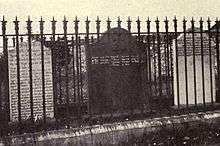
Upon Carlyle's death on 5 February 1881, it is a measure of his standing that interment in Westminster Abbey was offered; this was rejected by his executors due to Carlyle's expressed wish to be buried beside his parents in Ecclefechan.[51] His final words were, "So, this is death. Well!"[53]
Biography
Carlyle would have preferred that no biography of him was written, but when he heard that his wishes would not be respected and several people were waiting for him to die before they published, he relented and supplied his friend James Anthony Froude with many of his and his wife's papers. Carlyle's essay about his wife was included in Reminiscences, published shortly after his death by Froude, who also published the Letters and Memorials of Jane Welsh Carlyle annotated by Carlyle himself. Froude's Life of Carlyle was published over 1882–84. The frankness of this book was unheard of by the usually respectful standards of 19th-century biographies of the period.[54] Froude's work was attacked by Carlyle's family, especially his nephew, Alexander Carlyle[55] and his niece, Margaret Aitken Carlyle. However, the biography in question was consistent with Carlyle's own conviction that the flaws of heroes should be openly discussed, without diminishing their achievements. Froude, who had been designated by Carlyle himself as his biographer-to-be, was acutely aware of this belief. Froude's defence of his decision, My Relations With Carlyle, was published posthumously in 1903, including a reprint of Carlyle's 1873 will, in which Carlyle equivocated: "Express biography of me I had really rather that there should be none." Nevertheless, Carlyle in the will simultaneously and completely deferred to Froude's judgment on the matter, whose "decision is to be taken as mine."[56]
Views
Anglo-Saxonism
Described as one of the "most adamant protagonists" of Anglo-Saxonism,[57] Carlyle considered the Anglo-Saxon race as superior to all others.[58] In his lifetime, his shared Anglo-Saxonism with Ralph Waldo Emerson was described as a defining trait of their friendship.[59] Sometimes critical of the United States, describing it as a "formless" Saxon tribal order, he suggested that the Normans had provided Anglo-Saxons with a superior sense of order for national structure in England.[60]
Antisemitism
Carlyle held staunchly anti-Jewish views. Invited by Baron Rothschild in 1848 to support a Bill in Parliament to allow voting rights for Jews in the United Kingdom, Carlyle declined to offer his support to what he named the "Jew Bill". In a correspondence with Richard Monckton Milnes he insisted that Jews were hypocritical to want admission into the British Parliament, suggesting that a "real Jew" could only be a representative or citizen of "his own wretched Palestine", and in this context, declared that all Jews should be expelled to Palestine.[61] He was publicly criticized by Charles Dickens for his "well-known aversion to the Jews".[62] Playing into deeply anti-semitic stereotypes, Carlyle identified Jews with materialism and archaic forms of religion, attacking both the East London communities of Jewish orthodoxy and "West End" Jewish wealth, which he perceived as material corruption.[63]
Legacy
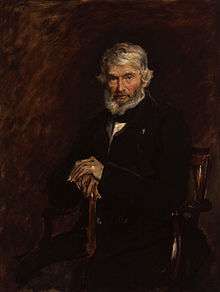
under Millais's hands the old Carlyle stood again upon the canvas as I had not seen him for thirty years. The inner secret of the features had been evidently caught. There was a likeness which no sculptor, no photographer, had yet equaled or approached. Afterward, I knew not how it seemed to fade away.
Thomas Carlyle is notable both for his continuation of older traditions of the Tory satirists of the 18th century in England and for forging a new tradition of Victorian era criticism of progress known as sage writing.[64] Sartor Resartus can be seen both as an extension of the chaotic, sceptical satires of Jonathan Swift and Laurence Sterne and as an enunciation of a new point of view on values.
Carlyle is also important for helping to introduce German Romantic literature to Britain. Although Samuel Taylor Coleridge had also been a proponent of Schiller, Carlyle's efforts on behalf of Schiller and Goethe would bear fruit.[65]
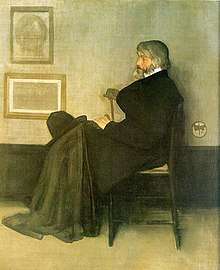
The reputation of Carlyle's early work remained high during the 19th century but declined in the 20th century. George Orwell called him "a master of belittlement. Even at his emptiest sneer (as when he said that Whitman thought he was a big man because he lived in a big country) the victim does seem to shrink a little. That [...] is the power of the orator, the man of phrases and adjectives, turned to a base use."[66] However, Whitman himself described Carlyle as lighting "up our Nineteenth Century with the light of a powerful, penetrating and perfectly honest intellect of the first-class" and "Never had political progressivism a foe it could more heartily respect".[67]
Carlyle's attacks on the ills of industrialisation and on classical economics were an important inspiration for U.S. progressives.[68] In particular, Carlyle criticised JS Mill's economic ideas for supporting Black Emancipation by arguing that Blacks' socio-economic status depended on economic opportunities rather than heredity.[69] Carlyle's racist justification for economic statism evolved into the elitist and eugenicist "intelligent social engineering" promoted early on by the progressive American Economic Association.[70]
His reputation in Germany was always high, because of his promotion of German thought and his biography of Frederick the Great. Friedrich Nietzsche, whose ideas are comparable to Carlyle's in some respects,[71][72] was dismissive of his moralism, calling him an "absurd muddlehead" in Beyond Good and Evil[73] and regarded him as a thinker who failed to free himself from the very petty-mindedness he professed to condemn.[74] Carlyle's distaste for democracy[75] and his belief in charismatic leadership was appealing to Joseph Goebbels, who frequently referenced Carlyle's work in his journal,[76] and read his biography of Frederick the Great to Hitler during his last days in 1945.[65][77] Many critics in the 20th century identified Carlyle as an influence on fascism and Nazism.[65] Ernst Cassirer argued in The Myth of the State that Carlyle's hero-worship contributed to 20th-century ideas of political leadership that became part of fascist political ideology.[78] Further evidence for this argument can be found in letters sent by Carlyle to Paul de Lagarde, one of the early proponents of the Fuehrer principle.[76]
Sartor Resartus has recently been recognized once more as a remarkable and significant work, arguably anticipating many major philosophical and cultural developments, from Existentialism to Postmodernism.[79] It has been argued that his critique of ideological formulas in The French Revolution provides a good account of the ways in which revolutionary cultures turn into repressive dogmatism.
Essentially a Romantic, Carlyle attempted to reconcile Romantic affirmations of feeling and freedom with respect for historical and political fact. Many believe that he was always more attracted to the idea of heroic struggle itself than to any specific goal for which the struggle was being made. However, Carlyle's belief in the continued use to humanity of the Hero, or Great Man, is stated succinctly at the end of his essay on Muhammad (in On Heroes, Hero-Worship & the Heroic in History), in which he concludes that: "the Great Man was always as lightning out of Heaven; the rest of men waited for him like fuel, and then they too would flame."[80]
A bust of Carlyle is in the Hall of Heroes of the National Wallace Monument in Stirling.
The name of ONE, Inc. was derived from an aphorism by Carlyle: "A mystic bond of brotherhood makes all men one".[81]
Works
- (1829) Signs of the Times. The Victorian Web
- (1833–34) Sartor Resartus. Project Gutenberg
- (1837) The French Revolution: A History. Project Gutenberg
- (1840) Chartism. Google Books
- (1841) On Heroes, Hero-Worship, and The Heroic in History. Project Gutenberg
- (1843) Past and Present. Project Gutenberg
- (1845) Oliver Cromwell's Letters and Speeches, with Elucidations, ed. Thomas Carlyle, 3 vol. (often reprinted).[82] Online version. Another online version.
- (1849) "Occasional Discourse on the Negro Question", Fraser's Magazine (anonymous), Online text
- (1850) Latter-Day Pamphlets. Project Gutenberg
- (1851) The Life of John Sterling. Project Gutenberg
- (1858) History of Friedrich II of Prussia. Index to Project Gutenberg texts
- (1867) Shooting Niagara: and After. Online Text
- (1875) The Early Kings of Norway. Project Gutenberg
- (1882) Reminiscences of my Irish Journey in 1849. Online text
- (1892) Lectures on the History of Literature
There are several published "Collected Works" of Carlyle:
Unauthorized lifetime editions:
- "Thomas' Carlyle's Ausgewählte Schriften", 1855–56, Leipzig. Translations by A. Kretzschmar. Abandoned after 6 vols.
Authorised lifetime editions:
- Uniform edition, Chapman and Hall, 16 vols, 1857–58.
- Library edition, Chapman and Hall, 34 vols (30 vols 1869–71, 3 additional vols added 1871 and one more 1875). The most lavish lifetime edition, it sold for 6 to 9 shillings per volume (or £15 the set)
- People's edition, Chapman and Hall, 39 vols (37 vols 1871–74, with 2 extra volumes added in 1874 and 1878). Carlyle insisted the price be kept to 2 shillings per volume.
- Cabinet edition, Chapman and Hall, 37 vols in 18, 1874 (printed from the plates of the People's Edition)
Posthumous editions:
- Centennial edition, Chapman and Hall, 30 vol, 1896–99 (with reprints to at least 1907). Introductions by Henry Duff Traill. The text is based on the People's edition, and it is used by many scholars as the standard edition of Carlyle's works.
- Norman and Charlotte Strouse edition (originally the California Carlyle edition), University of California Press, 1993–2006. Only 4 volumes were issued: On Heroes (1993), Sartor Resartus (2000), Historical Essays (2003) and Past and Present (2006). Despite being incomplete, it is the only critical edition of (some of) Carlyle's works.
Definitions
Carlyle had quite a few unusual definitions at hand, which were collected by the Nuttall Encyclopedia. Some include:
- Centre of Immensities
- An expression of Carlyle's to signify that wherever any one is, he is in touch with the whole universe of being, and is, if he knew it, as near the heart of it there as anywhere else he can be.
- Eleutheromania
- A mania or frantic zeal for freedom.
- Gigman
- Carlyle's name for a man who prides himself on, and pays all respect to, respectability. It is derived from a definition once given in a court of justice by a witness who, having described a person as respectable, was asked by the judge in the case what he meant by the word; "one that keeps a gig," was the answer. Carlyle also refers to "gigmanity" at large.
- Hallowed Fire
- An expression of Carlyle's in definition of Christianity "at its rise and spread" as sacred, and kindling what was sacred and divine in man's soul, and burning up all that was not.
- Mights and Rights
- The Carlyle doctrine that Rights are nothing till they have realised and established themselves as Mights; they are rights first only then.
- Pig-Philosophy
- The name given by Carlyle in his Latter-Day Pamphlets, in the one on Jesuitism, to the widespread philosophy of the time, which regarded the human being as a mere creature of appetite instead of a creature of God endowed with a soul, as having no nobler idea of well-being than the gratification of desire – that his only Heaven, and the reverse of it his Hell.
- Plugston of Undershot
- Carlyle's name for a "captain of industry" or member of the manufacturing class.
- Present Time
- Defined by Carlyle as "the youngest born of Eternity, child and heir of all the past times, with their good and evil, and parent of all the future with new questions and significance," on the right or wrong understanding of which depend the issues of life or death to us all, the sphinx riddle given to all of us to rede as we would live and not die.
- Prinzenraub (the stealing of the princes)
- Name given to an attempt to satisfy a private grudge of his, on the part of Kunz von Kaufungen to carry off, on the night of 7 July 1455, two Saxon princes from the castle of Altenburg, in which he was defeated by apprehension at the hands of a collier named Schmidt, through whom he was handed over to justice and beheaded. See Carlyle's account of this in his "Miscellanies."
- Printed Paper
- Carlyle's satirical name for the literature of France prior to the Revolution.
- Progress of the Species Magazines
- Carlyle's name for the literature of the day which does nothing to help the progress in question, but keeps idly boasting of the fact, taking all the credit to itself, like French Poet Jean de La Fontaine's fly on the axle of the careening chariot soliloquising, "What a dust I raise!"
- Sauerteig
- (i.e. leaven), an imaginary authority alive to the "celestial infernal" fermentation that goes on in the world, who has an eye specially to the evil elements at work, and to whose opinion Carlyle frequently appeals in his condemnatory verdict on sublunary things.
- The Conflux of Eternities
- Carlyle's expressive phrase for time, as in every moment of it a centre in which all the forces to and from eternity meet and unite, so that by no past and no future can we be brought nearer to Eternity than where we at any moment of Time are; the Present Time, the youngest born of Eternity, being the child and heir of all the Past times with their good and evil, and the parent of all the Future. By the import of which (see Matt. xvi. 27), it is accordingly the first and most sacred duty of every successive age, and especially the leaders of it, to know and lay to heart as the only link by which Eternity lays hold of it, and it of Eternity.
See also
References
- Carlyle, Thomas (1841). On Heroes, Hero-worship, & the Heroic in History. New York: D. Appleton & Co. p. 34.
The history of the world is but the biography of great men.
- "Thomas Carlyle | British essayist and historian". Encyclopedia Britannica. Retrieved 13 December 2019.
- Carlyle, Thomas (1849). "Occasional Discourse on the Negro Question". Fraser's Magazine for Town and Country. Vol. 40. p. 672.
- "Thomas Carlyle and Dumfries & Galloway". D&G online. Retrieved 9 July 2020.
- For a complete list of Carlyle's works, see Sheperd, Richard Herne (1881). The Bibliography of Carlyle, London: Elliot Scott.
- "He believed there was a God in heaven, and that God's laws, or God's justice, reigned on earth". – Lang, Timothy (2006). The Victorians and the Stuart Heritage: Interpretations of a Discordant Past. Cambridge University Press, p. 119 ISBN 978-0-521-02625-3
- DeTemple, Duane W. (February 1991). "Carlyle circles and Lemoine simplicity of polygon constructions" (PDF). The American Mathematical Monthly. 98 (2): 97–208. doi:10.2307/2323939. JSTOR 2323939. Archived from the original (PDF) on 21 December 2015. Retrieved 6 November 2011.
- "Carlyle – The Sage of Chelsea". English Literature For Boys And Girls. Farlex Free Library. Retrieved 19 September 2009.
- "Among these humble, stern, earnest religionists of the Burgher phase of Dissent Thomas Carlyle was born." – Sloan, John MacGavin (1904). The Carlyle Country, with a Study of Carlyle's Life. London: Chapman & Hall, p. 40.
- "As a 'double-goer', perplexing strangers in foreign parts as well as at home, the 'Apostle' was occasionally an innocent, inadvertent nuisance to 'our Tom'." – Wilson, David Alec (1923), Carlyle Till Marriage 1795 to 1826, London: Kegan Paul, Trench, Trubner & Co., pp. 42–43.
- Lundin, Leigh (20 September 2009). "Thomas Carlyle". Professional Works. Criminal Brief. Retrieved 20 September 2009.
- "Who2 Biography: Thomas Carlyle, Writer / Historian". Answers.com. 2009. Retrieved 19 September 2009.
- Nichol, John (1892). Thomas Carlyle. London: Macmillan & Co., p. 49.
- D. Daiches (ed.), Companion to Literature 1 (London, 1965), p. 89.
- Quoted in M. H. Abrams, The Mirror and the Lamp (Oxford, 1971), p. 217.
- I. Ousby (ed.), The Cambridge Guide to Literature in English (Cambridge, 1995), p. 828.
- "Everlasting No, The." In: Reverend James Wood (ed.), The Nuttall Encyclopædia, 1907.
- "Everlasting Yea, The." In: Reverend James Wood (ed.), The Nuttall Encyclopædia, 1907.
- "Sorrow, Worship of" In: Reverend James Wood (ed.), The Nuttall Encyclopædia, 1907.
- "Silence, Worship of" In: Reverend James Wood (ed.), The Nuttall Encyclopædia, 1907.
- I. Ousby (ed.), The Cambridge Guide to Literature in English (Cambridge, 1995), p. 350.
- Cumming, Mark (2004). The Carlyle Encyclopedia. Fairleigh Dickinson University Press, p. 223 ISBN 978-0-8386-3792-0
- Marcus, David D. (1976), "The Carlylean Vision of 'Tales of Two Cities'", Studies in the Novel 8 (1), pp. 56–68.
- Delaura, David J. (1969). "Ishmael as Prophet: Heroes and Hero-Worship and the Self-Expressive Basis of Carlyle's Art", Texas Studies in Literature and Language, Vol. 11, No. 1, pp. 705–732.
- Carlyle, Thomas (1869), On Heroes, Hero-Worship, & the Heroic in History, London: Chapman and Hall, 301.
- D. Daiches ed., Companion to Literature 1 (London, 1965), p. 90.
- Quoted in E. Halevy, Victorian Years (London, 1961), p. 40.
- "Reviews from the Neue Rheinische Zeitung Politish-Ökonomische Revue No. 4" contained in the Collected Works of Karl Marx and Frederick Engels: Volume 10 (International Publishers: New York, 1978) pp. 301–310.
- "Reviews from the Neue Rheinische Zeitung Politisch-Ökonomische Revue No. 4" contained in the Collected Works of Karl Marx and Frederick Engels: Volume 10, p. 306.
- Quoted in M. Sadleir, Trollope (London, 1945), p. 158.
- N. Frye, Anatomy of Criticism (Princeton, 1971), pp. 21 and 325.
- Carlyle, quoted in G. M. Trevelyan, An Autobiography (London, 1949), p. 175.
- Quoted in E. Halevy, Victorian Years (London, 1961), p. 257.
- Hall, Catherine (2002). Civilising Subjects: Metropole and Colony in the English Imagination, 1830–1867. University of Chicago Press, p. 25.
- Trella, D.J. (1992). "Carlyle's 'Shooting Niagara': The Writing and Revising of an Article and Pamphlet", Victorian Periodicals Review 25 (1), pp. 30–34.
- Ross, Greg (15 July 2018). "Peace and Quiet". Futility Closet. Retrieved 16 July 2018.
- Rines, George Edwin, ed. (1920). . Encyclopedia Americana.
- Rines, George Edwin, ed. (1920). . Encyclopedia Americana.
- I. Ousby (ed.), The Cambridge Guide to Literature in English (Cambridge, 1995), p. 154.
- "Book of Members, 1780–2010: Chapter C" (PDF). American Academy of Arts and Sciences. Retrieved 23 September 2016.
- Grindea, Miron, ed. (1978). The London Library. Ipswich: Boydell Press/Adam Books. pp. 9–13. ISBN 0-85115-098-5.
- Wells, John (1991). Rude Words: a discursive history of the London Library. London: Macmillan. pp. 12–56. ISBN 978-0333475195.
- Wells (1991), pp. 26–31.
- Heffer, Simon (1995). Moral Desperado – A Life of Thomas Carlyle. London: Weidenfeld & Nicolson, p. 48
- Howe, Susanne (1935). Geraldine Jewsbury, Her Life and Errors. London: George Allen & Unwin.
- Collis, John Stewart (1971). The Carlyles: A Biography of Thomas and Jane Carlyle. London: Sidgwick & Jackson.
- Leigh Hunt, 1784–1859, Poetry Foundation.
- Butler, Samuel (1935). Letters Between Samuel Butler and E.M.A. Savage 1871–1885. London: Jonathan Cape, p. 349.
- Froude, James (1903). My Relations with Carlyle. New York: Charles Scribner's Sons. On pages 21–24, Froude insinuates that Carlyle was impotent (p. 21): "She [Mrs. Carlyle] had longed for children, and children were denied to her. This had been at the bottom of all the quarrels and all the unhappiness"; (p. 22): "Intellectual and spiritual affection being all which he had to give [his wife]"; (p. 23): "Carlyle did not know when he married what his constitution was. The morning after his wedding-day he tore to pieces the flower-garden at the Comeley Bank in a fit of ungovernable fury."
- Harris, Frank. 'My Life and Loves' (London, Corgi 1973 p232 -243. ed. John F. Gallagher) claims that Carlyle had confessed his impotence to him personally, and records an account by Mrs Carlyle's doctor, who had examined and found her to be a virgin after 25 years of marriage. Harris's information is doubted by several scholars, the editor John Gallagher noted in a footnote.
- Mark Cumming (2004). The Carlyle Encyclopedia. Fairleigh Dickinson Univ Press. pp. 83–. ISBN 978-0-8386-3792-0. Retrieved 19 March 2013.
- Carlyle's House. Archived 15 October 2008 at the Wayback Machine,
- Conrad, Barnaby (1961). Famous Last Words. London: Alvin Redman, p. 21.
- Dunn, Waldo Hilary (1930). Froude & Carlyle, a Study of the Froude-Carlyle Controversy. London, Longmans, Green and Co.
- Carlyle, Alexander & Sir James Crichton-Browne (1903). The Nemesis of Froude: A Rejoinder to James Anthony Froude's "My Melations with Carlyle". New York and London: John Lane: The Bodley Head.
- "Will and Codicil of Thomas Carlyle, Esq.", in My Relations with Carlyle, New York: Charles Scribner's Sons, p. 73.
- Pieterse, Jan P. Nederveen (1989). Empire and Emancipation: Power and Liberation on a World Scale. Praeger. ISBN 978-0275925291.
- Frankel, Robert (2007). Observing America: The Commentary of British Visitors to the United States, 1890–1950 (Studies in American Thought and Culture). University of Wisconsin Press. pp. 54. ISBN 978-0299218805.
Thomas Carlyle was perhaps the first notable Englishman to enunciate a belief in Anglo-Saxon racial superiority, and, as he told Emerson, among the members of this select race he counted the Americans.
- Dent, Megan; Kerry, Paul; Pionke, Albert D. (2018). Thomas Carlyle and the Idea of Influence. Fairleigh Dickinson University Press. p. 130. ISBN 978-1683930655.
- Modarelli, Michael (2018). "Epilogue". The Transatlantic Genealogy of American Anglo-Saxonism. Routledge. ISBN 978-1138352605.
- Cumming, Mark (2004). The Carlyle Encyclopedia. Fairleigh Dickinson University Press. p. 252. ISBN 978-1611471724.
a Jew is bad but what is a Sham-Jew, a Quack-Jew? And how can a real Jew ... try to be Senator, or even Citizen of any Country, except his own wretched Palestine, whither all his thoughts and steps and efforts tend,-where, in the Devil's name, let him arrive as soon as possible, and make us quit of him!
- Eisner, Will (2013). Fagin The Jew 10th Anniversary Edition. Dark Horse Comics. p. 123.
- Kaplan, Fred (1993). Thomas Carlyle: A Biography. University of California Press. ISBN 978-0520082007.
Carlyle's active anti-Semitism was based primarily upon his identification of Jews with materialism and with an anachronistic religious structure. He was repelled by those "old clothes" merchants ... by "East End" orthodoxy, and by "West End" Jewish wealth, merchants clothed in new money who seemed to epitomize the intense material corruption of Western society.
- Holloway, John (1953). The Victorian Sage: Studies in Argument. London: Macmillan; Landow, George (1986). Elegant Jeremiahs: The Sage from Carlyle to Mailer. Ithaca, New York: Cornell University Press.
- Cumming, Mark (2004). The Carlyle Encyclopedia, Fairleigh Dickinson University Press, pp. 200ff; 223.
- Orwell, Review of the Two Carlyles by Osbert Burdett, The Adelphi, March 1931.
- Specimen Days by Walt Whitman (1883).Specimen Days
- Gutzke, D. (30 April 2016). Britain and Transnational Progressivism. Springer. ISBN 978-0-230-61497-0.
- Carlyle, Thomas. Occasional Discourse on the Negro Question.
- Leonard, Thomas C. (12 January 2016). Illiberal Reformers: Race, Eugenics, and American Economics in the Progressive Era (Reprint ed.). Princeton University Press.
- Grierson, H. J. C. (1933). Carlyle & Hitler: The Adamson Lecture in the University of Manchester. Cambridge: The University Press.
- Bentley, Eric (1944). A Century of Hero-worship, a Study of the Idea of Heroism in Carlyle and Nietzsche with Notes on Other Hero-worshipers of Modern Times. Philadelphia: J.B. Lippincott.
- Nietzsche, Friedrich (1907). Beyond Good and Evil. New York: The Macmillan Company, p. 210.
- Tambling, Jeremy (2007). "Carlyle through Nietzsche: Reading Sartor Resartus", The Modern Language Review, Vol. 102, No. 2, pp. 326–340.
- Lippincott, Benjamin Evans (1938), Victorian Critics and Democracy: Carlyle, Ruskin, Arnold, Stephen, Maine, Lecky, London: H. Milford, Oxford University Press.
- Steinweis, Alan (June 1995). "Hitler and Carlyle's 'historical greatness'". History Today. 45: 35.
- Ryback, Timothy W. (2010). Hitler's Private Library: The Books that Shaped His Life. New York: Random House.
- Casirer, Ernest (1946). The Myth of the State. Yale: Yale University Press. See also Voegelin, Eric (2001). Selected Book Reviews. The Collected Works of Eric Voegelin, Vol. XIII. Columbia: University of Missouri Press, pp. 156–158.
- Gravil, Richard (2007). Existentialism. Humanities, p. 35; Böhnke, Dietmar (2004). Shades of Gray: Science Fiction, History and the Problem of Postmodernism in the Works of Alidair Gray. Berlin: Galda & Wilch, p. 73; d'Haen, Theo & Pieter Vermeulen (2006). Cultural Identity and Postmodern Writing. Amsterdam: Editions Rodopi, p. 141.
- Carlyle, Thomas (1840), On Heroes, Hero-worship and the Heroic in History, London: Chapman and Hall, p. 90.
- David K. Johnson: The Lavender Scare: The Cold War Persecution of Gays and Lesbians in the Federal Government, University of Chicago Press, 2004, ISBN 9780226404813, p. 34
- Morrill, John (1990). "Textualizing and Contextualizing Cromwell," Historical Journal 33 (3), pp. 629–639. Examines the Abbott and Carlyle edit.
Bibliography
- Chandler, Alice (1998), "Carlyle and the Medievalism of the North". In: Richard Utz and Tom Shippey (eds), Medievalism in the Modern World. Essays in Honour of Leslie J. Workman, Turnhout: Brepols, pp. 173–191.
- Ikeler, A. A. (1972), Puritan Temper and Transcendental Faith. Carlyle's Literary Vision, Columbus, OH: Ohio State University Press.
- MacDougall, Hugh A. (1982), Racial Myth in English History: Trojans, Teutons, and Anglo-Saxons, Montreal: Harvest House & University Press of New England.
- Roe, Frederick William (1921), The Social Philosophy of Carlyle and Ruskin, New York: Harcourt, Brace & Company.
- Waring, Walter (1978), Thomas Carlyle, Boston: Twayne Publishers.
Further reading
- Caird, Edward (1892). "The Genius of Carlyle". In: Essays on Literature and Philosophy, Vol. I. Glasgow: James MacLehose & Sons, pp. 230–267.
- Cobban, Alfred (1963), "Carlyle's French Revolution," History, Vol. XLVIII, No. 164, pp. 306–316.
- Cumming, Mark (1988), A Disimprisoned Epic: Form and Vision in Carlyle's French Revolution. University of Pennsylvania Press.
- Harrold, Charles Frederick (1934), Carlyle and German Thought: 1819–1834. New Haven: Yale University Press.
- Kaplan, Fred (1983), Thomas Carlyle: A Biography. Berkeley: University of California Press.
- Müller, Max (1886), "Goethe and Carlyle," The Contemporary Review, Vol. XLIX, pp. 772–793.
- Lecky, W.E.H. (1891), "Carlyle's Message to his Age," The Contemporary Review, Vol. LX, pp. 521–528.
- Norton, Charles Eliot (1886), "Recollections of Carlyle," The New Princeton Review, Vol. II, No. 4, pp. 1–19.
- Rigney, Ann (1996). "The Untenanted Places of the Past: Thomas Carlyle and the Varieties of Historical Ignorance," History and Theory, Vol. XXXV, No. 3, pp. 338–357.
- Rosenberg, John D. (1985), Carlyle and the Burden of History. Cambridge, Mass.: Harvard University Press.
- Rosenberg, Philip (1974), The Seventh Hero. Thomas Carlyle and the Theory of Radical Activism, Cambridge, Mass.: Harvard University Press.
- Stephen, James Fitzjames (1865), "Mr. Carlyle", Fraser's Magazine, Vol. LXXII, pp. 778–810.
- Symons, Julian (1952), Thomas Carlyle: The Life and Ideas of a Prophet, New York: Oxford University Press.
- Vanden Bossche, Chris (1991), Carlyle and the Search for Authority, Columbus: Ohio State University Press.
- Wellek, René (1944). "Carlyle and the Philosophy of History," Philological Quarterly, Vol. XXIII, No. 1, pp. 55–76.
- Macpherson, Hector Carswell (1896), "Thomas Carlyle," Famous Scots Series, Oliphant, Anderson and Ferrier
External links
| Wikisource has original works written by or about: Thomas Carlyle |
| Wikiquote has quotations related to: Thomas Carlyle |
| Wikimedia Commons has media related to Thomas Carlyle. |
- "Thomas Carlyle and Dumfries & Galloway". D&G online. Dumfries and Galloway. 19 November 2018. Retrieved 28 January 2020.
- Thomas Carlyle's Birthplace, National Trust for Scotland
- Thomas & Jane Carlyle's Craigenputtock the official site
- Works by Thomas Carlyle at Project Gutenberg
- Works by or about Thomas Carlyle at Internet Archive
- Works by Thomas Carlyle at LibriVox (public domain audiobooks)

- Poems by Thomas Carlyle at PoetryFoundation.org
- The Carlyle Letters Online
- "Archival material relating to Thomas Carlyle". UK National Archives.

- A guide to the Thomas Carlyle Collection at the Beinecke Rare Book and Manuscript Library
- Portraits of Thomas Carlyle at the National Portrait Gallery, London

- The Ecclefechan Carlyle Society
- The Green Snake and the Beautiful Lily,Thomas Carlyle's translation (1832) from the German of Goethe's Märchen or Das Märchen
| Academic offices | ||
|---|---|---|
| Preceded by William Ewart Gladstone |
Rector of the University of Edinburgh 1865–1868 |
Succeeded by James Moncreiff |